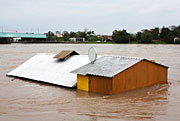- Number 347 |
- October 3, 2011
Mastering the mysteries of the MJO

The Madden-Julian Oscillation,
an atmospheric wave, influences
weather patterns around the
world, such as tropical monsoons,
floods, cyclones and
thunderstorms.
From monsoons in Mumbai to windstorms in Seattle, weather patterns around the world are influenced by the MJO or Madden-Julian Oscillation. And now, scientists can model its energy cycle, thanks to DOE’s Pacific Northwest National Laboratory and the National Center for Atmospheric Research. The MJO is a 30- to 60-day atmospheric wave that affects weather from the Indian Ocean to the West Coast of the United States. Global climate models do not have a clear picture of the MJO. The PNNL and NCAR study shows how the MJO gets its energy and how its access to moisture affects the wave’s regularity and recurrence. Understanding the oscillation and capturing its features will help scientists better predict weather variations that affect millions of people. DOE’s Atmospheric Systems Research program funded this research. The National Center for Computational Sciences provided resources through the INCITE Climate-Science Computational End Station Development project.
[Kristin Manke, 509.372.6011,
kristin.manke@pnnl.gov]
